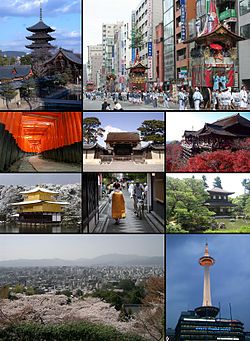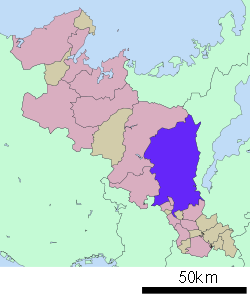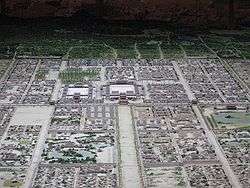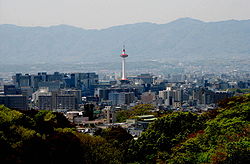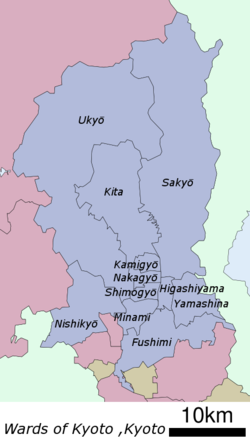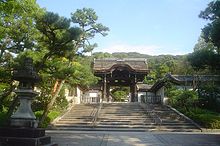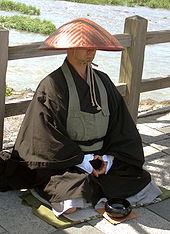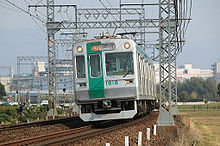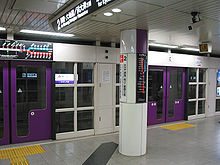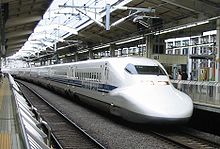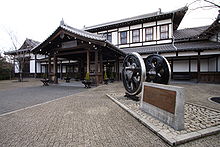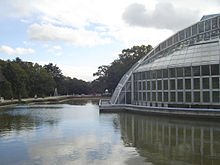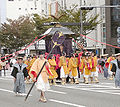- Kyoto
-
For other uses, see Kyoto (disambiguation).
Kyoto
京都— Designated city — 京都市 · Kyoto City From top left: Tō-ji, Gion Matsuri in modern Kyoto, Fushimi Inari-taisha, Kyoto Imperial Palace, Kiyomizu-dera, Kinkaku-ji, Pontochō and Maiko, Ginkaku-ji, Cityscape from Higashiyama and Kyoto Tower 
Flag
LogoLocation of Kyoto in Kyoto Prefecture Coordinates: 35°0′42″N 135°46′6″E / 35.01167°N 135.76833°ECoordinates: 35°0′42″N 135°46′6″E / 35.01167°N 135.76833°E Country Japan Region Kansai Prefecture Kyoto Prefecture Government - Mayor Daisaku Kadokawa (門川大作) Area - Total 827.90 km2 (319.7 sq mi) Population (August 1, 2011) - Total 1,473,746 - Density 1,780.1/km2 (4,610.4/sq mi) Time zone Japan Standard Time (UTC+9) City Symbols - Tree Weeping Willow, Japanese Maple and Katsura - Flower Camellia, Azalea and Sugar Cherry Phone number 075-222-3111 Address 488 Teramachi-Oike, Nakagyō-ku, Kyōto-shi, Kyōto-fu
604-8571Website City of Kyoto Kyoto (京都市 Kyōto-shi, "Capital City") (Japanese pronunciation: [kʲoːto] (
 listen)) is a city in the central part of the island of Honshū, Japan. It has a population close to 1.5 million. Formerly the imperial capital of Japan, it is now the capital of Kyoto Prefecture, as well as a major part of the Osaka-Kobe-Kyoto metropolitan area.
listen)) is a city in the central part of the island of Honshū, Japan. It has a population close to 1.5 million. Formerly the imperial capital of Japan, it is now the capital of Kyoto Prefecture, as well as a major part of the Osaka-Kobe-Kyoto metropolitan area.Contents
History
Main article: Heian-kyōAlthough archaeological evidence places the first human settlement on the islands of Japan to approximately 10,000 BC, relatively little is known about human activity in the area before the 6th century AD, around which time the Shimogamo Shrine is believed to have been established. During the 8th century, when the powerful Buddhist clergy became involved in the affairs of the Imperial government, the Emperor chose to relocate the capital to a region far from the Buddhist influence. Emperor Kammu selected the village of Uda, at the time in the Kadono district of Yamashiro Province, for this honor.[1]
The new city, Heian-kyō (平安京, "tranquility and peace capital"), a scaled replica of the then Tang capital Chang'an,[2] became the seat of Japan's imperial court in 794, beginning the Heian period of Japanese history. Although military rulers established their governments either in Kyoto (Muromachi shogunate) or in other cities such as Kamakura (Kamakura shogunate) and Edo (Tokugawa shogunate), Kyoto remained Japan's capital until the transfer of the imperial court to Tokyo in 1869 at the time of the Imperial Restoration. (Some believe that it is still a legal capital: see Capital of Japan.)
The city suffered extensive destruction in the Ōnin War of 1467-1477, and did not really recover until the mid-16th century. Battles between samurai factions spilled into the streets, and came to involve the court nobility (kuge) and religious factions as well. Nobles' mansions were transformed into fortresses, deep trenches dug throughout the city for defense and as firebreaks, and numerous buildings burned. The city has not seen such widespread destruction since.
In late 16th century, Toyotomi Hideyoshi restructured the city by building new streets to double the number of north-south streets in central Kyoto, creating rectangle blocks superseding ancient square blocks. Hideyoshi also built earthwork walls called Odoi (御土居) circulating the city. Teramachi Street in central Kyoto is a Buddhist temple quarter where Hideyoshi gathered temples in the city. Throughout the Edo period, the economy of the city flourished as one of three major cities in Japan, the others being Osaka and Edo.
The Hamaguri rebellion of 1864 burnt down 28,000 houses in the city, and the subsequent move of the Emperor to Tokyo in 1869 weakened the economy. The modern city of Kyoto was formed on April 1, 1889. The construction of Lake Biwa Canal in 1890 is one measure taken to revive the city. The population of the city exceeded one million in 1932.[3]
There was some consideration by the United States of targeting Kyoto with an atomic bomb at the end of World War II because, as an intellectual center of Japan, it had a population "better able to appreciate the significance of the weapon."[4] In the end, at the insistence of Henry L. Stimson, Secretary of War in the Roosevelt and Truman administrations, the city was removed from the list of targets and replaced by Nagasaki. The city was largely spared from conventional bombing as well, although small-scale air raids did result in casualties.
As a result, Kyoto is one of the few Japanese cities that still has an abundance of prewar buildings, such as the traditional townhouses known as machiya. However, modernization is continually breaking down the traditional Kyoto in favor of newer architecture, such as the Kyoto Station complex.
Kyoto became a city designated by government ordinance on September 1, 1956. In 1997, Kyoto hosted the conference that resulted in the protocol on greenhouse gas emissions that bears the city's name.
Name
In Japanese, the city has been called Kyō (京), Miyako (都) or Kyō no Miyako (京の都). In the 11th century, the city was renamed Kyoto ("capital city"), after the Chinese word for capital city, jingdu (京都).[5] After Edo was renamed Tokyo (meaning "Eastern Capital") in 1868, Kyoto was known for a short time as Saikyō (西京, meaning "Western Capital").
An obsolete spelling for the city's name is Kioto; it was formerly known to the West as Meaco or Miako (Japanese: 都; miyako, meaning "the seat of Imperial palace" or "capital".). Another term commonly used to refer to the city in the pre-modern period was Keishi (京師), meaning "metropolis" or "capital".
Geography
 Golden Pavilion at Kinkaku-ji during Autumn 2010
Golden Pavilion at Kinkaku-ji during Autumn 2010
Historic Monuments of Ancient Kyoto (Kyoto, Uji and Otsu Cities) * UNESCO World Heritage SiteCountry Japan Type Cultural Criteria ii, iv Reference 688 Region ** Asia-Pacific Inscription history Inscription 1994 (18th Session) * Name as inscribed on World Heritage List
** Region as classified by UNESCOKyoto is located in a valley, part of the Yamashiro (or Kyoto) Basin, in the eastern part of the mountainous region known as the Tamba highlands. The Yamashiro Basin is surrounded on three sides by mountains known as Higashiyama, Kitayama and Nishiyama, with a height just above 1,000 metres (3,281 ft) above sea level. This interior positioning results in hot summers and cold winters. There are three rivers in the basin, the Ujigawa to the south, the Katsuragawa to the west, and the Kamogawa to the east. Kyoto City takes up 17.9% of the land in the prefecture with an area of 827.9 km²
The original city was arranged in accordance with traditional Chinese feng shui following the model of the ancient Chinese capital of Chang'an (present-day Xi'an). The Imperial Palace faced south, resulting in Ukyō (the right sector of the capital) being on the west while Sakyō (the left sector) is on the east. The streets in the modern-day wards of Nakagyō, Shimogyō, and Kamigyō still follow a grid pattern.
Today, the main business district is located to the south of the old Imperial Palace, with the less-populated northern area retaining a far greener feel. Surrounding areas do not follow the same grid pattern as the center of the city, though streets throughout Kyoto share the distinction of having names.
Kyoto sits atop a large natural water table that provides the city with ample freshwater wells. Due to large scale urbanization, the amount of rain draining into the table is dwindling and wells across the area are drying at an increasing rate.
Demographics
Historically Kyoto was the largest city in Japan, later surpassed by Osaka and Edo (Tokyo) towards the end of the 16th century. In the prewar years, Kyoto traded places with Kobe and Nagoya ranking as the 4th and 5th largest city. In 1947, it went back to being 3rd, but its population has gradually declined ever since. By 1960 it had fallen to 5th again, and by 1990 it had fallen to 7th. If current trends continue it could fall to 9th after Fukuoka and Kawasaki.
Climate
Kyoto has a Humid subtropical climate (Koppen Cfa).
Climate data for Kyoto Month Jan Feb Mar Apr May Jun Jul Aug Sep Oct Nov Dec Year Average high °C (°F) 8
(47)9
(48)13
(55)19
(67)24
(75)27
(81)31
(88)33
(91)28
(82)22
(72)17
(62)11
(52){{{year high C}}}
(69)Average low °C (°F) 0
(32)1
(33)3
(37)8
(47)13
(56)18
(64)22
(72)23
(74)19
(67)12
(54)7
(44)2
(36){{{year low C}}}
(53)Precipitation mm (inches) 52
(2.05)66
(2.6)112
(4.41)152
(5.98)155
(6.1)249
(9.8)234
(9.21)142
(5.59)203
(7.99)112
(4.41)69
(2.72)41
(1.61)1,587
(62.48)Source: weather.com Politics and government
The directly elected executive mayor in Kyoto as of 2011 is Daisaku Kadokawa, an independent supported by the Liberal Democratic Party, Democratic Party of Japan, New Komeito Party and Social Democratic Party. The legislative city assembly has 69 elected members.
Kyoto City Assembly
Political party Number of seats Liberal Democratic Party 22 Japanese Communist Party 20 Democratic Party of Japan 14 New Komeito Party 12 vacant 1 Elections
Wards
Main article: Wards of KyotoKyoto has eleven wards. They are
- Fushimi-ku (伏見区)
- Higashiyama-ku (東山区)
- Kamigyō-ku (上京区)
- Kita-ku (北区)
- Minami-ku (南区)
- Nakagyō-ku (中京区) - administrative center
- Nishikyō-ku (西京区)
- Sakyo-ku (左京区)
- Shimogyō-ku (下京区)
- Ukyō-ku (右京区)
- Yamashina-ku (山科区)
Together, they comprise the city of Kyoto. Like other cities in Japan, Kyoto has a single mayor and a city council.
Culture
Although ravaged by wars, fires, and earthquakes during its eleven centuries as the imperial capital, Kyoto was spared from much of the destruction of World War II. It was removed from the atomic bomb target list (which it had headed) by the personal intervention of Secretary of War Henry L. Stimson, as Stimson wanted to save this cultural center which he knew from his honeymoon and later diplomatic visits.[6][7]
With its 2000 religious places- 1600 Buddhist temples and 400 Shinto shrines, as well as palaces, gardens and architecture intact, it is one of the best preserved cities in Japan. Among the most famous temples in Japan are Kiyomizu-dera, a magnificent wooden temple supported by pillars off the slope of a mountain; Kinkaku-ji, the Temple of the Golden Pavilion; Ginkaku-ji, the Temple of the Silver Pavilion; and Ryōan-ji, famous for its rock garden. The Heian Jingū is a Shinto shrine, built in 1895, celebrating the Imperial family and commemorating the first and last emperors to reside in Kyoto. Three special sites have connections to the imperial family: the Kyoto Gyoen area including the Kyoto Imperial Palace and Sento Imperial Palace, homes of the Emperors of Japan for many centuries; Katsura Imperial Villa, one of the nation's finest architectural treasures; and Shugaku-in Imperial Villa, one of its best Japanese gardens.
Other notable sites in Kyoto include Arashiyama, the Gion and Pontochō geisha quarters, the Philosopher's Walk, and the canals which line some of the older streets.
The "Historic Monuments of Ancient Kyoto" are listed by the UNESCO as a World Heritage Site. These include the Kamo Shrines (Kami and Shimo), Kyō-ō-Gokokuji (Tō-ji), Kiyomizu-dera, Daigo-ji, Ninna-ji, Saihō-ji (Kokedera), Tenryū-ji, Rokuon-ji (Kinkaku-ji), Jishō-ji (Ginkaku-ji), Ryōan-ji, Hongan-ji, Kōzan-ji and the Nijo Castle, primarily built by the Tokugawa shoguns. Other sites outside the city are also on the list.
Kyoto is renowned for its abundance of delicious Japanese foods and cuisine. The special circumstances of Kyoto as a city away from the sea and home to many Buddhist temples resulted in the development of a variety of vegetables peculiar to the Kyoto area (kyōyasai, 京野菜).
Japan's television and film industry has its center in Kyoto. Many jidaigeki, action films featuring samurai, were shot at Toei Uzumasa Eigamura.[8] A film set and theme park in one, Eigamura features replicas of traditional Japanese buildings which are used for jidaigeki. Among the sets are a replica of the old Nihonbashi (the bridge at the entry to Edo), a traditional courthouse, a Meiji Period police box and part of the former Yoshiwara red-light district. Actual film shooting takes place occasionally, and visitors are welcome to observe the action.
Kyoto International Manga Museum is also situated in Kyoto. For an entrance fee visitors are able to view exhibitions and read as much manga as they desire. The museum is making an attempt to acquire every manga ever published and so far houses approximately 200,000 titles.
Economy
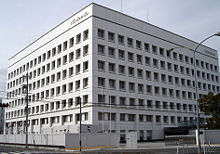 The exterior of Nintendo's main headquarters in Kyoto
The exterior of Nintendo's main headquarters in Kyoto
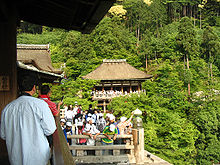 Tourists at Kiyomizu-dera
Tourists at Kiyomizu-dera
The key industry of Kyoto is information technology and electronics: the city is home to the headquarters of Nintendo, Intelligent Systems, TOSE, OMRON, Kyocera, Shimadzu Corp., Rohm, Horiba, Nidec Corporation, Nichicon, GS Yuasa and Murata Machinery and the headquarters of Murata Manufacturing are located in the suburbs of Kyoto in the city of Nagaokakyō.
Tourism also forms a large base of Kyoto's economy. The city's cultural heritages are constantly visited by school groups from across Japan, and many foreign tourists also stop in Kyoto. In 2007, the city government announced that a record number of tourists had visited Kyoto for the sixth year in a row.,[9] and it was chosen as the second most attractive city in Japan, in a regional brand survey.[10]
Traditional Japanese crafts are also major industry of Kyoto, most of which are run by artisans in small plants. Kyoto's kimono weavers are particularly renowned, and the city remains the premier center of kimono manufacturing. Such businesses, vibrant in past centuries, have declined in recent years as sales of traditional goods stagnate.
Sake brewing is Kyoto's traditional industry. Gekkeikan and Takara Holdings are major sake brewers headquartered in Kyoto.
Other businesses headquartered in Kyoto include the apparel company Wacoal, the delivery transportation company Sagawa Express and the garage kits maker Volks.
Colleges and universities
Home to 37 institutions of higher education, Kyoto is one of the academic centers of the country. Kyoto University, one of Japan's national universities, is considered to be one of the top universities in Japan. According to The Times Higher Education Supplement top-ranking university, Kyoto University is ranked the second university in Japan and 25th in the world.[11] The Kyoto Institute of Technology is also among the most famous universities in Japan and is considered to be one of the best universities for architecture and design in the country. Doshisha University and Ritsumeikan University are popular private universities in the Osaka-Kobe-Kyoto metropolitan area.
Kyoto also has a unique higher education network called the Consortium of Universities in Kyoto, which consists of three national, five public (prefectural and municipal), and 41 private universities, as well as the city and four other organizations. The consortium does not offer a degree, but offers the courses as part of a degree at participating universities.[12]
As well as more than 30 Japanese universities and colleges, American universities find the city as an important place for education and research. Kyoto Consortium for Japanese Studies (KCJS) is a consortium of 14 American universities that sponsors a rigorous, two-semester academic program for undergraduates who wish to do advanced work in Japanese language and cultural studies. In addition, Stanford University has its own Japan Center in Kyoto.[13]
Transportation
See also: Transportation in Greater Osaka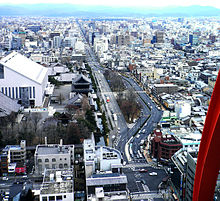 Roads seen from Kyoto Tower
Roads seen from Kyoto Tower
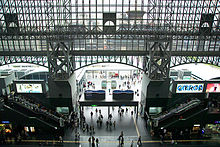 Inside Kyoto Station
Inside Kyoto Station
Rail
See also: Keihan Electric Railway, Hankyu Railway, and Kintetsu CorporationKyoto Station is the center for transportation in the city. The second-largest in Japan, it houses a shopping mall, hotel, movie theater, Isetan department store, and several local government facilities all under one fifteen-story roof. The Tōkaidō Shinkansen Line (see below) as well as all conventional rail lines operated by JR West connect here.
The Keihan, Hankyu, Kintetsu, and other rail networks also offer frequent service to other cities in the Kansai region. JR West and Kintetsu connect at Kyoto Station. Hankyu has a terminal at the intersection of Shijō Kawaramachi, Kyoto's most thriving shopping and amusement district. Keihan has a station at Sanjō Keihan which is not far from Shijō Kawaramachi.
Subway
Main article: Kyoto Municipal SubwayThe Kyoto Municipal Transportation Bureau operates the Kyoto Municipal Subway consisting of two lines: the Karasuma Line and the Tōzai Line.
Karasuma Line
Main article: Karasuma LineAn express service bound for Kokusaikaikan Station of the Karasuma Line is running on the Kintetsu Nara Line.
The Karasuma Line is colored green, and its stations are given numbers following the letter K.
The line has following stations, from north to south: Kokusaikaikan (terminal) and Matsugasaki in Sakyō-ku; Kitayama and Kitaōji in Kita-ku; Kuramaguchi and Imadegawa in Kamigyō-ku; Marutamachi and Karasuma Oike in Nakagyō-ku; Shijō, Gojō and Kyōto in Shimogyō-ku; Kujō and Jūjō in Minami-ku; and Kuinabashi and Takeda (terminal) in Fushimi-ku.
Between Kitaōji and Jūjō, trains run beneath the north-south Karasuma Street (ja:烏丸通 Karasuma-dori), hence the name. They link to the other subway line, the Tozai Line, at Karasuma Oike. They also connect to the JR lines at Kyoto Station and the Hankyu Kyoto Line running cross-town beneath Shijō Street at the intersection of Shijō Karasuma, Kyoto's central business district. At Shijō Karasuma, the subway station is named Shijō, whereas Hankyu's station is called Karasuma.
The Transportation Bureau and Kintetsu Corporation jointly operate through services, which continue to the Kintetsu Kyoto Line to Kintetsu Nara Station in Nara. The Karasuma Line and the Kintetsu Kyoto Line connect at Kyoto and Takeda. All the stations are located in the city proper.
Tozai Line
Main article: Tōzai Line (Kyoto)The Tōzai Line is coloured vermilion, and its stations are given numbers following the letter T. This line runs from the southeastern area of the city, then east to west (i.e. tōzai in Japanese) through the Kyoto downtown area where trains run beneath the three east-west streets: Sanjō Street (ja:三条通 Sanjō-dori), Oike Street (ja:御池通 Oike-dori) and Oshikōji Street (ja:押小路通 Oshikōji-dori).
The line has following stations, from east to west: Rokujizō (terminal) in Uji; Ishida and Daigo in Fushimi-ku; Ono, Nagitsuji, Higashino, Yamashina and Misasagi in Yamashina-ku; Keage, Higashiyama and Sanjō Keihan in Higashiyama-ku; Kyoto Shiyakusho-mae, Karasuma Oike, Nijōjō-mae, Nijō and Nishiōji Oike in Nakagyō-ku; and Uzumasa Tenjingawa (terminal) in Ukyō-ku.
The Keihan Keishin Line has been integrated into this line, and thus Keihan provides through services from Hamaōtsu in the neighbouring city of Ōtsu, the capital of Shiga Prefecture.
The Tōzai Line connects to the Keihan lines at Rokujizō, Yamashina, Misasagi and Sanjō Keihan, to the JR lines at Nijō, Yamashina and Rokujizō, and to the Keifuku Electric Railroad at Uzumasa Tenjingawa. All the stations except Rokujizō are located in Kyoto.
High speed rail
Shinkansen at Kyoto Station Main articles: Tōkaidō Shinkansen and Sanyō ShinkansenSee also: Central Japan Railway Company and West Japan Railway Company
Main articles: Tōkaidō Shinkansen and Sanyō ShinkansenSee also: Central Japan Railway Company and West Japan Railway CompanyThe Tōkaidō Shinkansen operated by JR Central provides high-speed rail service linking Kyoto with Nagoya, Yokohama and Tokyo to the east of Kyoto and with nearby Osaka and points west on the San'yo Shinkansen, such as Kobe, Okayama, Hiroshima, Kitakyushu and Fukuoka. The trip from Tokyo takes about two hours and twenty-two minutes. From Hakata in Fukuoka, Nozomi takes you to Kyoto in just over three hours. All trains including Nozomi stop at Kyoto Station, serving as a gateway to not only Kyoto Prefecture but also northeast Osaka, south Shiga and north Nara.
Airport
See also: Kansai International Airport and Itami Airport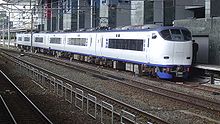 Kansai Airport express Haruka at Kyoto Station
Kansai Airport express Haruka at Kyoto Station
Although Kyoto does not have its own airport, travelers can get to the city via Kansai International Airport and Itami Airport in Osaka Prefecture. The Haruka Express operated by JR West carries passengers from Kansai Airport to Kyoto Station in 73 minutes.
JR-WEST: Travel Information > Access to Kansai Airport
Osaka Airport Transport buses connect Itami Airport and Kyoto Station Hachijo Exit in an hour and cost 1,280 yen for a one-way trip. Some buses go further, make stops at major hotels and intersections in downtown, and get to Nijō Station or the Westin Miyako Hotel Kyoto near Keage Station of Municipal Subway Tozai Line.
Buses
Kyoto's municipal bus network is extensive. Private carriers also operate within the city. Many tourists join commuters on the public buses, or take tour buses. Kyoto's buses have announcements in English and electronic signs with stops written in the Latin alphabet.
Most city buses have a fixed fare. A one-day bus pass and a combined unlimited train and bus pass are also available. These are especially useful for visiting many different points of interest within Kyoto. The bus information center just outside the central station handles tickets and passes. The municipal transport company publishes a very useful leaflet called "Bus Navi." It contains a route map for the bus lines to most sights and fare information. This too is available at the information center in front of the main station.
Buses operating on routes within the city, the region, and the nation stop at Kyoto Station. In addition to Kyoto Station, bus transfer is available at the intersections of Shijō Kawaramachi and Sanjō Keihan. The intersection of Karasuma Kitaōji to the north of downtown has a major bus terminal serving passengers who take the Karasuma Line running beneath Karasuma Street, Kyoto's main north-south street.
Cycling
Cycling is a very important form of personal transportation in the city. The geography and scale of the city are such that the city may be easily navigated on a bicycle. Bicycle theft is not common, but finding permitted bicycle parking areas can be difficult. Bicycles parked in non-permitted areas are impounded.
Roads
The city is connected with other part of Japan by the Meishin Expressway, which has two interchanges in the city: Kyoto Higashi (Kyoto East) in Yamashina-ku and Kyoto Minami (Kyoto South) in Fushimi-ku. The Kyoto Jūkan Expressway connects the city to northern regions of Kyoto Prefecture. The Daini Keihan Road is a new bypass (completed in 2010) to Osaka.
Unlike other metropolitan cities of Japan, Kyoto has poor network of intra-city expressways. As of 2010, only 8.2 km of the Hanshin Expressway Kyoto Route is in operation.[14]
There are nine national highways in the city of Kyoto: Route 1, Route 8, Route 9, Route 24, Route 162, Route 171, Route 367, Route 477 and Route 478.
Tourism
See also: Tourism in JapanKyoto contains roughly 2,000 temples and shrines, and receives over 30 million tourists annually.[15]
The UNESCO World Heritage Site
About 20% of Japan's National Treasures and 14% of Important Cultural Properties exist in the city proper. The UNESCO World Heritage Site Historic Monuments of Ancient Kyoto (Kyoto, Uji and Otsu Cities) includes 17 locations in Kyoto, Uji in Kyoto Prefecture and Ōtsu in Shiga Prefecture. The site has been designated as World Heritage in 1994.
-
Tō-ji (東寺)
-
Kiyomizu-dera (清水寺)
-
Saihō-ji (西芳寺)
-
Tenryū-ji (天龍寺)
-
Kinkaku-ji (金閣寺)
-
Ryōan-ji (龍安寺)
-
Nijō Castle (二条城)
-
Daigo-ji (醍醐寺)
-
Ginkaku-ji (銀閣寺)
-
Ninna-ji (仁和寺)
-
Kōzan-ji (高山寺)
Iwatayama monkey park
Main article: Iwatayama Monkey ParkThe Iwatayama Monkey Park (popularly called "Monkey Mountain") in Nishikyō-ku is a park where monkeys roam freely. The park itself is inhabited by a troupe of over 170 Japanese macaque monkeys. After paying admission, one walks up a steep hill, at the top of which is an enclosure where visitors may go in and safely feed the monkeys. As there are no fences, the monkeys can come and go as they please, but they are especially tempted by food such as apples or peanuts. Even though the animals are wild, they have become accustomed to humans, and so are not afraid to come close to tourists bearing food.
Museums and gardens
- Umekoji Steam Locomotive Museum (梅小路蒸気機関車館)
- Onishi Seiwemon Museum (大西清右衛門美術館)
- Kitamura Museum (北村美術館)
- The Kyoto Arashiyama Orgel Museum (京都嵐山オルゴール美術館)
- Kyoto City Heiankyo Sosei-Kan Museum (京都市平安京創生館)
- Kyoto Municipal Museum of Art (京都市美術館)
- Kyoto City Archaeological Museum (京都市考古資料館)
- Kyoto Art Center (京都芸術センター)
- The Kyoto International Manga Museum (京都国際マンガミュージアム)
- The National Museum of Modern Art, Kyoto (京都国立近代美術館)
- The Kyoto National Museum (京都国立博物館)
- The Kyoto University Museum (京都大学総合博物館)
- Kyoto Museum of Traditional Crafts (京都伝統産業ふれあい館)
- The Museum of Kyoto (京都府京都文化博物館)
- The Kyoto Botanical Garden (京都府立植物園)
- Garden of Fine Arts, Kyoto (京都府立陶板名画の庭)
- Kyoto Prefectural Insho-Domoto Museum of Fire Arts (京都府立堂本印象美術館)
- Koryo Museum of Art (高麗美術館)
- Joutenkaku Museum (承天閣美術館)
- Ryozen Museum of History (幕末維新ミュージアム 霊山歴史館)
- Sen-oku Hakuko Kan (泉屋博古館)
- Toei Kyoto Studio Park (東映太秦映画村)
- Nomura Art Museum (野村美術館)
- Namikawa Cloisonne Museum of Kyoto (並河靖之七宝記念館)
- The Yurinkan Museum (藤井斉成会有鄰館)
- The Tin Toy Museum (ブリキのおもちゃ博物館)
- The Hosomi Museum (細見美術館)
- Hakusasonso Hashimoto Kansetsu Memorial Museum and Garden (白沙村荘 橋本関雪記念館)
- The Raku Museum (楽美術館)
- Kyoto Museum for World Peace of Ritsumeikan University (立命館大学国際平和ミュージアム)
- Ōkōchi Sansō (大河内山荘)
- The Kyoto Kaleidoscope Museum (京都万華鏡ミュージアム)
Festivals
Kyoto is well known for its traditional festivals which have been held for over 1000 years and are a major tourist attraction.[16] The first is the Aoi Matsuri on May 15. Two months later (July 1 to 31) is the Gion Matsuri known as one of the 3 great festivals of Japan, culminating in a massive parade on July 17. Kyoto marks the Bon Festival with the Gozan Okuribi, lighting fires on mountains to guide the spirits home (August 16). The October 22 Jidai Matsuri, Festival of the Ages, celebrates Kyoto's illustrious past.
-
Gion Matsuri (祇園祭)
-
Aoi Matsuri (葵祭)
-
Jidai Matsuri (時代祭)
Sports
Soccer
In soccer, Kyoto is represented by Kyoto Sanga F.C. who won the Emperor's Cup, in 2002, and rose to J. League's Division 1 in 2005. Kyoto Sanga has a long history as an amateur non-company club, although it was only with the advent of professionalization that it was able to compete in the Japanese top division.
Amateur football clubs such as F.C. Kyoto BAMB 1993 and Kyoto Shiko Club (both breakaway factions of the original Kyoto Shiko club that became Kyoto Sanga) as well as unrelated AS Laranja Kyoto compete in the regional Kansai soccer league.
Baseball
With the popularity of the nearby Hanshin Tigers, Kyoto has never had a team in Nippon Professional Baseball, though the Tigers played a neutral-site game at Kyoto's Nishikyogoku Baseball Stadium every year until 2005, excluding 1999. The Tigers had a poor record when playing at the stadium for 11 years (no game for the rain in 1998, 2002, 2003, and 2004, and 6 successive losses inserting the cancellation). The professional baseball games at Nishikyogoku Baseball Stadium revived in 2010, because the stadium became the home of a girls professional baseball team, the Kyoto Asto Dreams.
Additionally, Kyoto's high school baseball teams are strong, with Heian and Toba in particular making strong showings recently at the annual tournament held in Koshien Stadium, Nishinomiya, Hyōgo, near Osaka.
International relations
Twin towns — Sister cities
The city of Kyoto has a sister city relationship with:[17]
 Boston, United States
Boston, United States Paris, France (Friendship Pledge city)
Paris, France (Friendship Pledge city) Cologne, Germany
Cologne, Germany Cuzco, Peru
Cuzco, Peru Konya, Turkey
Konya, Turkey Prague, Czech Republic
Prague, Czech Republic Florence, Italy
Florence, Italy Kiev, Ukraine
Kiev, Ukraine Xi'an, People's Republic of China (Friendship city)
Xi'an, People's Republic of China (Friendship city) Guadalajara, Mexico
Guadalajara, Mexico Zagreb, Croatia
Zagreb, Croatia
See also
- List of Kyoto's Bridges
- List of Kyoto's Buddhist Temples
- List of Kyoto's Fires
- List of Shinto shrines in Kyoto
References
Bibliography
- Fiévé, Nicolas (ed.). (2008).Atlas historique de Kyôto. Analyse spatiale des systèmes de mémoire d’une ville, de son architecture et de ses paysages urbains. Foreword Kôichirô Matsuura, Preface Jacques Gernet, Paris, Éditions de l’UNESCO / Éditions de l’Amateur, 528 pages, 207 maps et 210 ill.ISBN 978-2-85917-486-6.
- Fiévé, Nicolas and Waley, Paul. (2003). Japanese Capitals in Historical Perspective: Place, Power and Memory in Kyoto, Edo and Tokyo. London: Routledge. 417 pages + 75 ill. 10-ISBN 0-700-71409-X; 13-ISBN 978-0-700-71409-4
- Lone, John. (2000). Old Kyoto: A Short Social History. Oxford: Oxford University Press. ISBN 0-19-590940-2.
- Ponsonby-Fane, Richard A. B. (1956). Kyoto: The Old Capital of Japan, 794–1869. Kyoto: The Ponsonby Memorial Society.
- Ropke, Ian Martin. Historical Dictionary of Osaka and Kyoto. (1999) 273pp
- Stewart, Harold. (1981). By the Old Walls of Kyoto: A Year's Cycle of Landscape Poems with Prose Commentaries. New York: Weatherhill. ISBN 083480154X.
- Titsingh, Isaac. (1834). [Siyun-sai Rin-siyo/Hayashi Gahō, 1652], Nipon o daï itsi ran; ou, Annales des empereurs du Japon. Paris: Oriental Translation Fund of Great Britain and Ireland. ...Click link for digitized, full-text copy of this book (in French)
- Wyden, Peter. (1984). Day One: Before Hiroshima and After. Simon & Schuster, Inc. ISBN 0-671-46142-7.
Notes
- ^ Kyoto Exhibitors' Association (1910) Kyoto Kyoto Exhibitors' Association of the Japan-British exhibition, Kyoto, p. 3 OCLC 1244391
- ^ Ebrey, Walthall & Palais 2006, p. 103.
- ^ City of Kyoto (2003). "情報統計担当(京都市の統計情報)/よくある質問/人口・世帯". http://www.city.kyoto.jp/sogo/toukei/guide/Faq/p_oth002.html. Retrieved July 5, 2010.
- ^ Wyden, Peter. (1984). Day One: Before Hiroshima and After, page 196.
- ^ Lowe, John. (2000). Old Kyoto: A short Social History, p. x.
- ^ The Manhattan Project, Department of Energy at mbe.doe.gov
- ^ HyperHistory.net http://www.hyperhistory.net/apwh/bios/b4stimson-henrylewis.htm. Dec. 22, 2009. Retrieved August 7, 2010.
- ^ "Welcome to Kyoto — Toei Uzumasa Eigamura Movie Museum". Pref.kyoto.jp. http://www.pref.kyoto.jp/visitkyoto/en/theme/others/uzumasa_movie/. Retrieved 2010-03-07.
- ^ "Kyoto tourism setting new record for 6th year in a row". Japan News Review. 2007-07-06. http://www.japannewsreview.com/society/kansai/20070706page_id=398. Retrieved 2010-03-07.
- ^ "Sapporo picked as "most attractive town" for 2nd consecutive year — J-Cast". En.j-cast.com. 2007-07-23. http://en.j-cast.com/2007/08/09009922.html. Retrieved 2010-03-07.
- ^ "The Times Higher Education Supplement World University Rankings". http://www.timeshighereducation.co.uk/hybrid.asp?typeCode=431&pubCode=1&navcode=148. Retrieved 2010-02-10.
- ^ [1][dead link]
- ^ "Stanford Japan Center". Stanford-jc.or.jp. 1999-02-22. http://www.stanford-jc.or.jp/index.html. Retrieved 2010-03-07.
- ^ Hanshin Expressway. "阪神高速の各種データ" (in Japanese) (pdf). http://www.hanshin-exp.co.jp/company/technology/kakusyudata.pdf. Retrieved September 24, 2010.
- ^ Scott, David (1996). Exploring Japan. Fodor's Travel Publications, Inc. ISBN 0-679-03011-5.
- ^ Kyoto Visitors Guide (1998). Kyoto Tourist Office, Kyoto City Council.
- ^ "Kyoto City Web / Data Box / Sister Cities". www.city.kyoto.jp. http://www.city.kyoto.jp/koho/eng/databox/sister.html. Retrieved 2010-01-14.
External links
- Kyoto Travel Guide — City of Kyoto and Kyoto Tourism Council
- Kyoto City Local Government (English)
- Kyoto Guide including interactive map & over 1,300 pictures.
- Kyoto's temples & shrines— Information on 26 temples and shrines.
- Photos of Kyoto, mostly temples and shrines.
- Kyoto travel guide from Wikitravel
 Kyoto Prefecture
Kyoto PrefectureKyoto (capital city) 
Other cities Funai District Kuse District Otokuni District Sōraku District Tsuzuki District Yosa District Metropolitan cities of Japan Tokyo Metropolis Designated cities Core cities Akita · Amagasaki · Aomori · Asahikawa · Fukuyama · Funabashi · Gifu · Hakodate · Higashiōsaka · Himeji · Iwaki · Kagoshima · Kanazawa · Kashiwa · Kawagoe · Kōchi · Kōriyama · Kumamoto · Kurashiki · Kurume · Maebashi · Matsuyama · Miyazaki · Morioka · Nagano · Nagasaki · Nara · Nishinomiya · Ōita · Okazaki · Ōtsu · Shimonoseki · Takamatsu · Takasaki · Takatsuki · Toyama · Toyohashi · Toyota · Utsunomiya · Wakayama · YokosukaSpecial cities Akashi · Atsugi · Chigasaki · Fuji · Fukui · Hachinohe · Hirakata · Hiratsuka · Ibaraki · Ichinomiya · Isesaki · Jōetsu · Kakogawa · Kasugai · Kasukabe · Kawaguchi · Kishiwada · Kōfu · Koshigaya · Kumagaya · Kure · Matsumoto · Mito · Nagaoka · Neyagawa · Numazu · Odawara · Ōta · Sasebo · Sōka · Suita · Takarazuka · Tokorozawa · Tottori · Toyonaka · Tsukuba · Yamagata · Yamato · Yao · YokkaichiPrefectural capitals
(not included above)World Heritage Sites in Japan Hokkaidō Tōhoku Shirakami-Sanchi · Historic Monuments and Sites of Hiraizumi
Kantō Shrines and Temples of Nikkō · Ogasawara Islands
Chūbu Historic Villages of Shirakawa-gō and Gokayama · Sacred Sites and Pilgrimage Routes in the Kii Mountain Range1
Kansai Buddhist Monuments in the Hōryū-ji Area · Himeji Castle · Historic Monuments of Ancient Kyoto (Kyoto, Uji and Otsu Cities) · Historic Monuments of Ancient Nara · Sacred Sites and Pilgrimage Routes in the Kii Mountain Range1
Chūgoku Kyūshū Gusuku Sites and Related Properties of the Kingdom of Ryukyu · Yakushima
1 Shared with other region/sWorld's fifty most-populous urban areas Categories:- Populated places established in the 8th century
- 1889 establishments in Japan
- Buddhist pilgrimages
- Kyoto
- Former capitals of Japan
- Environmental model cities
- Populated places established in 1889
Wikimedia Foundation. 2010.

